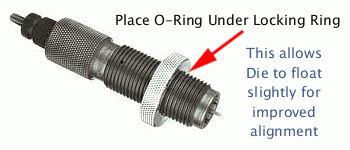TECH TIP: Use Rubber O-Rings with Sizing Dies for Less Run-Out
Here’s an inexpensive tip that can help you load straighter ammo, with slightly better measured concentricity (i.e. less run-out) on the case necks and bullets. Simply use a rubber O-Ring on the underside of the die locking ring. This allows the die to self-align itself (slightly) to the case that is being sized. Without the O-Ring, if the flat surface on the top of your press is not perfectly square with the thread axis, your die can end up slightly off-angle. This happens when the bottom of the locking ring butts up tight against the top of the press.

Top prone shooter German Salazar has tried this trick and he says it works: “Go to your local hardware store and get a #17 O-Ring (that’s the designation at Ace Hardware, don’t know if its universal). Slip the O-Ring on the die and re-adjust the lock ring so that the O-Ring is slightly compressed when the die is at the correct height. Size and measure a few more cases. You will probably see a slight improvement in neck concentricity as the die can now float a bit as the case enters and leaves it. This isn’t going to be a dramatic improvement, but it’s a positive one.”

Lee Precision makes die lock rings with built-in O-Rings. Lee’s distinctive lock ring design allows the same kind of self-alignment, which is good. However, Lee lock rings don’t clamp in place on the die threads, so they can move when you insert or remove the dies — and that can throw off your die setting. By using an O-Ring under a conventional die lock ring, you get the advantages of the Lee design, without the risk of the lock ring moving.


















I’ve suggested this technique to others and have been laughed at. Glad to see it posited here as something that can work for you, if you’re open to it.
Big new deal, not. Lee Precision has been selling a die nut with ingegral o-ring for years. And yes, they do reduce case run-out when re-sizing.
Me, again. I neglected to add that the Lee rings hold the die adjustment just fine. With very few exceptions, I have been using Lee rings on most of my sizing dies for 20+ years without any of the perceived problems. You just need to tighten them snugly with your fingers, and loosen them the same way. The o-ring also engages the die body to hold your adjustment. You only get into trouble when you grip the die when tightening or loosening.
Lee dies do not hold the adjustment, period. Of course you can try to work around their limitations, but it’s not going to work and replacing with decent lock rings is easier anyway.
And with German’s tip, you’d have to mark your press and die lock ring in order to be able to return to the same setting (instead of being forced to measure the sized cases against your chamber every time).
In the end, it boils down to the fact how much you want to control the length-wise sizing. 2 degrees error (1/180 of full turn) when adjusting dies is 0.01mm/0.0004″ in base-to-shoulder length.
With all due respect, repeatable settings are possible by indexing the nut, hence the die, to any chosen spot on the press. I use either a casting seam, or the 6:00 position, whatever. Try it, it works, every time.
Guess I’ve just been lucky. I’ve been using the Lee O-ring lock nuts for years on all my dies (Redding, RCBS, and Lee) for years with the above mentioned finger tighten technique with excellent results…with no loss of adjustment problems. Works for me.